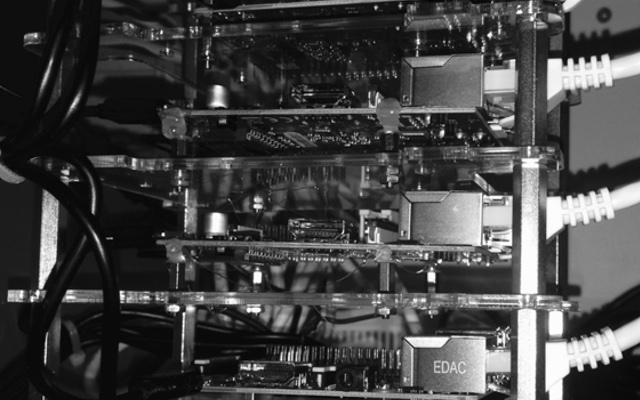
This is the second part in a series of posts describing how I have setup Gogs and Drone on Kubernetes-On-ARM cluster. In Part 1 we talked about setting up Gogs.
In this part I’ll explain how to setup service-loadbalancer to expose services
outside the cluster.
I’m using Lucas Käldström:s great
kubernetes-on-arm project.
There’s a load-balancer addon based on kubernetes/contrib/service-loadbalancer
that wasn’t ready in the 0.6.3 release.
Before we begin you might take a look at service-loadbalancer.
What I did was to build the service-loadbalancer from the
kubernetes/contrib master branch. Once again Lucas have made a great job and
created a docker file for building the Kubernetes-ARM binaries on x86.
$ # Clone the repository
$ git clone https://github.com/luxas/kubernetes-on-arm
$ # Build the Docker image
$ cd kubernetes-on-arm/scripts/build-k8s-on-amd64
$ docker build -t build-k8s-on-amd64 .
$ # Create a container
$ docker run --name=build-k8s-on-amd64 build-k8s-on-amd64 true
$ # Copy out the binaries from the container
$ docker cp build-k8s-on-amd64:/output .
The service-loadbalancer binary is located in the output directory.
Transfer the file to the nodes that will have the role of load-balancer.
e.g.
$ scp ./output/service-loadbalancer \ xxx.xxx.xxx.xxx:/etc/kubernetes/source/images/kubernetesonarm/_bin/latest
The service-loadbalancer uses a template for creating a ha-proxy.cfg.
The template I’m using can be found here: template.cfg
On each node build the kubernetesonarm/loadbalancer image.
$ cd /etc/kubernetes/source/images/kubernetesonarm/loadbalancer
$ mv template.cfg template.cfg.org
$ wget wget https://goo.gl/TzvKhX -O template.cfg
$ ./build.sh
Phew… were half way. The Docker image is in place on our nodes. Now we need
to label them so that the scheduler can place the service-loadbalancer on the
right nodes.
$ kubectl label --overwrite nodes <node name> role=loadbalancer
$ kubectl get nodes
NAME LABELS STATUS AGE
<node name> kubernetes.io/hostname=<node name>,role=loadbalancer Ready 2d
Now it’s time to create the loadbalancer. If you wan’t to use https you need
to create a secret and mount the volume in your pod template.
Here’s my loadbalancer-rc.yaml:
apiVersion: v1
kind: ReplicationController
metadata:
name: service-loadbalancer
namespace: kube-system
labels:
app: service-loadbalancer
version: v1
spec:
replicas: 1
selector:
app: service-loadbalancer
version: v1
template:
metadata:
labels:
app: service-loadbalancer
version: v1
spec:
nodeSelector:
role: loadbalancer
volumes:
- name: ssl-volume
secret:
secretName: kodbasen-ssl-secret
containers:
- image: kubernetesonarm/loadbalancer
livenessProbe:
httpGet:
path: /healthz
port: 8081
scheme: HTTP
initialDelaySeconds: 30
timeoutSeconds: 5
name: haproxy
ports:
# All http services
- containerPort: 80
hostPort: 80
protocol: TCP
# nginx https
- containerPort: 443
hostPort: 443
protocol: TCP
# mysql
- containerPort: 3306
hostPort: 3306
protocol: TCP
# haproxy stats
- containerPort: 1936
hostPort: 1936
protocol: TCP
# gogs ssh
- containerPort: 2222
hostPort: 2222
protocol: TCP
volumeMounts:
- name: ssl-volume
readOnly: true
mountPath: "/ssl"
resources: {}
args:
- --tcp-services=my-gogs-ssh:2222
- --ssl-cert=/ssl/server.pem
- --ssl-ca-cert=/ssl/ca.crt
He’re you can see that I’ve exposed the my-gogs-ssh as a TCP service.
Now we’re ready to expose our Gogs service to the outside world. We need to change our Gogs service from Part 1 slightly and add some annotations.
apiVersion: v1
kind: Service
metadata:
annotations:
serviceloadbalancer/lb.sslTerm: "true"
serviceloadbalancer/lb.host: "gogs.replace.me"
serviceloadbalancer/lb.cookie-sticky-session: "true"
labels:
app: my-gogs-service
name: my-gogs-service
namespace: default
spec:
ports:
- port: 80
protocol: TCP
targetPort: 3000
selector:
app: my-gogs
sessionAffinity: None
type: ClusterIP
serviceloadbalancer/lb.sslTerm: "true" annotation says that we wan’t to
use httpsserviceloadbalancer/lb.host: "gogs.replace.me" is the virtual hostserviceloadbalancer/lb.cookie-sticky-session: "true" enables sticky sessions
between your pods (replicas > 1)If everything is working you should be rewarded with a ha-proxy status page
where you can monitor your exposed services. Fire up
http://<loadbalancer ip>:1936/ in your favorite browser and take a look.
That is all for now. In the next part we will take a look at the CI tool
Drone and how to get it working on our
Kubernetes-ARM cluster. Prepare for a journey down the rabbit hole.
8 Feb 2016 #Development #Docker #Kubernetes #Raspberry PI #Gogs #Drone